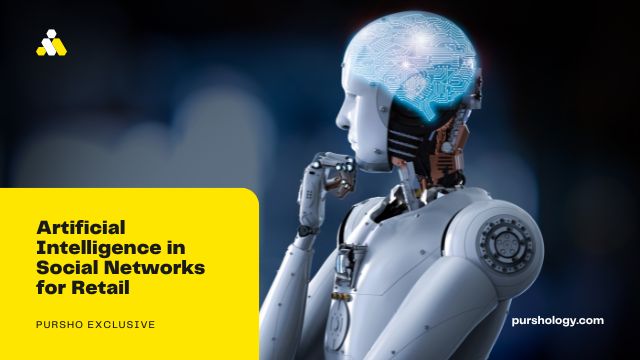The retail industry is an excellent example of a “segment” in which AI can have real impact. The reason is simple: there are lots of factors that determine what sells and what doesn’t. In the retail world, these factors are:
- Price
- Availability (when you have to go to a mall)
- Trends (seasonality, time of day)
- Convenience (when you want to shop quickly, not at home)
- Retail services (maintenance and repair, returns)
- The use of AI in social media can help retailers target potential customers and improve customer service.
Artificial Intelligence in Social Networks for Retail
The use of AI in social media can help retailers target potential customers and improve customer service. While the use of AI for retail is still young and the data available is still limited, it is already showing great promise. In a recent report from analysis firm Gartner, they found that consumer sentiment and churn rates are both on the decline. This reduction in consumer sentiment may be due to rising client expectations, as well as lower spending on discretionary items by consumers. The technology behind this positive effect is Artificial Intelligence (AI), which allows marketers to better understand consumer behavior across time and space, enabling them to create new insights into their target audiences. Dealerships are also using AI in this manner, even though they are not yet equipped with the hardware or software required to run it themselves.
AI can also help retailers manage inventory and predict consumer trends.
Artificial intelligence (AI) is one of the most important and rapidly advancing technologies in the 21st century. AI, in short, is a learning algorithm which learns from data and uses that data to create new algorithms, which are then applied to other data sets.
In the retail industry it currently allows for the automation of a lot of processes that would otherwise be done manually. This includes picking items in stores, following trends and analyzing customer behavior to identify upcoming purchases.
Retailers can use AI to help predict demand and manage inventory. For example, retailers can use AI to analyze personal shopping history like when a user was last at a certain store or when they have visited that store before or if they are buying certain items regularly or if they have recently changed their clothing or shoes. They can also use AI to predict trends between seasonal sales and brand loyalty (e.g., shoppers who buy frequently will be more likely to purchase during certain months).
Although there are different types of AI out there (i.e., supervised vs unsupervised), most retail applications used AI software for processing items in stores as well as in warehouse management (i.e., finding out if an item has been sold).
Websites change every day so how information is shared differs from day-to-day depending on retailer-to-retailer relations and on whether the website is owned by the retailer or by a third party like Google, Amazon or Facebook. Furthermore, there are different types of retailers: physical stores like Wal-Mart sell only goods while online retailers sell mostly digital products (e.g., books/music/video).
It’s also important for us not to confuse machine learning with artificial intelligence because both are different approaches which consider how we learn from data and how we learn from experience rather than whether an algorithm actually “understands” anything at all (and therefore it’s not considered artificial intelligence). The term “AI” should be reserved for supervised learning algorithms applying abstractions such as rulesets and decision trees instead of specific algorithms with specific characteristics such as whether it tries each possible outcome equally often (supervised learning).
Conclusion: The use of AI in social media is a powerful tool that can help retailers improve their business.
In 2010, CNET reported that the retail industry would spend a total of $5.5 billion for social media marketing in 2013. Facebook and Twitter clearly dominate, with a combined $2.2 billion in 2013, but others have come on strongly as well: Groupon ($1.35 billion) and Google+ ($1.6 billion). There are a few other brands that are spending big on social media: Nike spent $2 million on Facebook in 2012; The North Face spent $1 million; Macy’s spent $750,000; JCPenney spent just under half a million; and Lowe’s spent over $150,000.
In this post I want to focus specifically on the use of artificial intelligence (AI) in social networks for retail (a relatively new area of commerce). The goal is to give an overview of how retailers are using AI to improve their business and how they can apply it to their existing products or develop entirely new ones.
Here is the framework I will use:
- The first thing we have to do is define what AI means: it may mean many different things to different people, depending on who you ask (and who you ask for.) You could say it means machine learning or deep learning — you really need some training data before you can put it into practice — but there has never been one definition for what AI actually means. And if there is such a definition, stop me if you think we are addressing its value here!
- The second thing we have to do is understand what we want from AI systems: We want them to engage with our customers in meaningful ways and produce better results than they could with human input alone; we want them doing it on demand; and we want them doing it in the context of multiple participants while they are engaged with other tasks at the same time — not just one person performing multiple tasks at once while thinking about something else entirely! In fact, this last point should be paramount since many firms seem to forget that humans can multitask quite well (and thus should be able to do so), yet still feel as if they must do something rather than think about something else entirely — which is one reason why most firms don’t use their employees as general-purpose tools for interacting with customers!
- The third thing we have to do is understand how AIs work: While some AIs could be thought of as simple computers (or better yet automated




